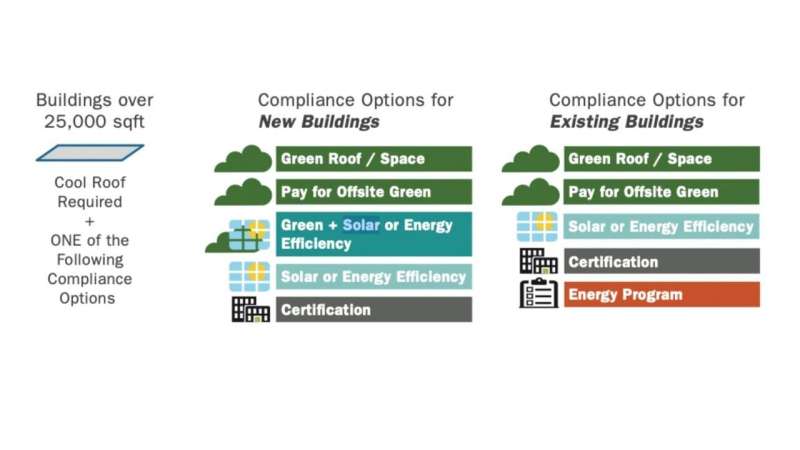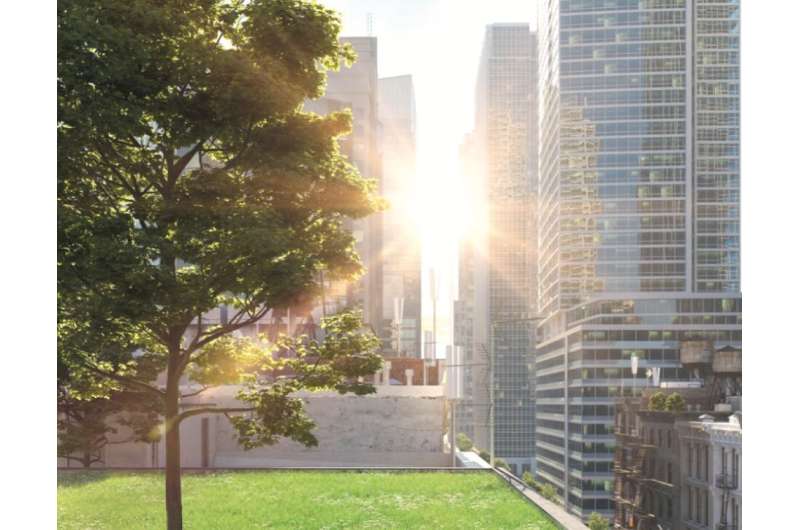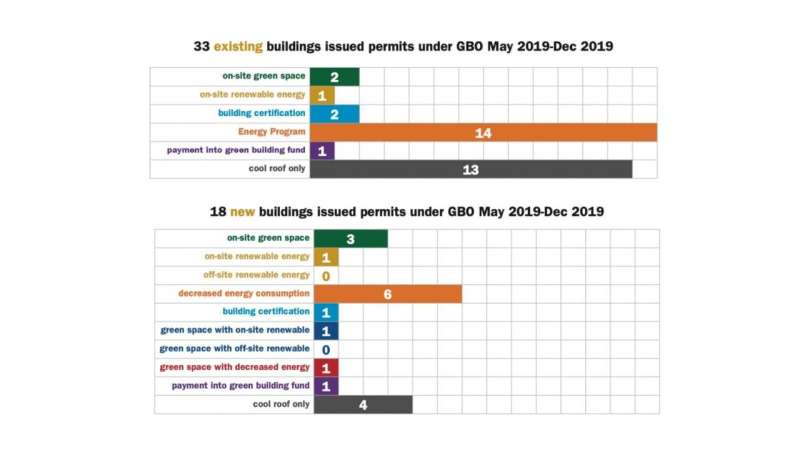Green roofs or green buildings?

Imagine flying over Denver and spotting a cluster of downtown skyscrapers with vast swaths of green roofs visible at different heights. It would be enchanting, and it would be green—figuratively and literally.
In fact, Denverites did more than imagine it. They voted the idea into law in January 2018 when the Green Roofs Initiative passed. The original initiative required all new commercial buildings over 25,000 square feet to install a green roof. This was a powerful symbol that voters were committed to sustainable building practices. Once constructed, the city would have clear visual proof of its citizens' convictions.
After the initiative passed, however, the discussion of its implementation began in earnest—and it wasn't looking feasible. The Green Roofs Initiative became the Green Buildings Ordinance by the end of 2018, after the Green Roofs Review Task Force issued its recommendations. The group—composed of people from academia, industry, government, and creators/supporters of the original initiative—met nine times throughout the first half of 2018, eventually drafting a proposal that was circulated to the public for input. The resulting Green Buildings Ordinance became effective on Nov. 2, 2018.
The transition displeased some voters, and multiple news stories depicted the new initiative as a bad compromise. Some people viewed the switch from green roofs to green options as a denial of voters' rights. To get some perspective on this issue, we turned to Professor Austin Troy, Ph.D., chair of urban and regional planning department at CU Denver's College of Architecture and Planning.
Author of The Very Hungry City, Troy specializes in urban "green infrastructure" and other aspects of urban sustainability. The Green Buildings Ordinance "is meant to be the best greening strategy for different people," he said. "The original law as written was really popular, but it hadn't been very thought out in how it was going to apply to different development types across Denver."
The original Green Roofs Initiative offered developers, construction companies, engineers, and architects what Troy referred to as "a one-size-fits-all approach." On the other hand, the now-adopted Green Buildings Ordinance gives people in the industry more choices. "I was very strongly in favor of making the law more flexible and dynamic from the beginning," Troy said.
What Are the Green Choices Then?
The Green Buildings Ordinance permits new buildings over 25,000 feet to choose from a series of nine green-energy options in these areas: green roofs/green space, solar/renewable energy, energy efficiency, green building certifications (third-party programs), payment to the Green Building Fund, and the Energy Program (for roof replacement).

Data from the first annual review of the Green Buildings Ordinance, which was published on Apr. 28, 2020, states that approximately 65 construction projects complied with the ordinance and that the most frequently selected options involved greater energy efficiency.
That does not mean Denver is not receiving proposals that include the sought-after green roofs. Christy Collins, Green Buildings Ordinance Specialist for Denver Community Planning and Development, said, "We're definitely seeing them [green roofs] in proposals." She added, "Design teams are more selective of where they put them, so they have greater impact."
Additionally, the proposed green roofs are often accompanied by other options that increase energy efficiency. The first annual report states the benefits of these 65 new buildings: "These projects will collectively use less energy, add more green space, and contribute less to the urban heat island effect, among other health and environmental benefits, than they would have without this crucial law."
The Green Roofs Review Task Force
The original Green Roofs Initiative was based on a law that was written for the city of Toronto, which has considerably different weather conditions and building codes. "I don't think many of the original supporters ever thought it was going to pass," Troy said. Both Troy and Collins agree that when the initiative did pass, Denver needed to adjust the law to fit the city of Denver.
One of the first things to tackle was the Green Roofs Review Task Force itself. The 10 members came from a variety of industries and organizations. Laura Swartz, Communications Director for Denver Community Planning and Development, explained the process. "An important part of the task force was that it was balanced," she said. "It included proponents who worked really hard to get this [Green Roofs Initiative] on the ballot and voted in; it also included people who'd initially been opposed to the ballot … It was an invigorating process to see these groups come together."
Of its 10 members, the Green Roofs Review Task Force included four individuals with connections to the University of Colorado. Besides two alumni, the group included Abigail Christman, survey coordinator of CU Denver's Center of Preservation Research (CoPR), and Jennifer Bousselot, who works for the cross-institutional (CU Denver and CSU) Colorado Living Architecture Regional Center of Excellence.

Expensive to Build, Expensive to Maintain
If green roofs are a beautiful solution to create more environmentally friendly urban spaces, then why aren't new construction projects choosing green roofs? Because of cost. "Green roofs are so expensive because of the structural support needed to support all that soil," Troy said. "Irrigation on a roof is very expensive and drainage on the roof too," he added.
Besides having the structural design needed to support the weight of a green roof, a new building that integrates a green roof needs "features that help support survivability," Collins said. "In our climate, growing right and installing correctly requires a licensed vegetative roof contractor to install it," she added.
The Green Roofs Initiative had great intentions, but it needed to be adjusted in order to have the greatest impact. "If everyone has to build a green roof," Troy said, "then investors would be forced to spend a lot of money for something that wouldn't get a lot of use in many circumstances." Planting at ground level, adding trees and vegetation around buildings, and integrating energy-saving materials, on the other hand, can be much more cost-effective in delivering environmental benefits than a green roof for certain types of building sites. "The last thing you want to do is have developers forgo low-cost greening strategies because they have to build a green roof," Troy said.
Denverites Committed to Sustainability
Instead of focusing on the green roofs Denver did not get, citizens might focus on the positive impact Denver did receive from the revised law. The first annual review shows that large new construction projects did address climate change and improve health: "Energy efficiency and solar panels on buildings are good for the bottom line and affordability because they lower operating expenses, improve net operating income (NOI), and can help attract tenants. Cool roofs and green spaces reduce the urban heat island. Green spaces on and around buildings improve the human experience as well as water quality and storm water management."
"Denver did a good job of taking the spirit of the law," Troy said. Collins puts it simply: "The intent is that it's fully achievable." In a city currently undergoing a building boom, the Green Buildings Ordinance has already benefitted the community after its first year of implementation. There are many projects that incorporate a combination of sustainability practices, including green roofs.
COVID-19 has slowed down some construction projects. While building is deemed an essential service, crews have had to adopt new safety regulations. "Like all critical businesses, construction sites must comply with social distancing guidelines and must maintain a clean and safe work environment," said Amanda Weston, Marketing and Communications Specialist for Denver Community Planning and Development.
Hopefully, the pandemic will only strengthen the city's commitment to environmentally friendly design. Given that the Green Roof Initiative was passed by voters and that Denverites are eager to see more green roofs, the city is showing a commitment to urban sustainability. "The Green Buildings Ordinance definitely shows our community has a strong interest in building performance," Swartz said.
















